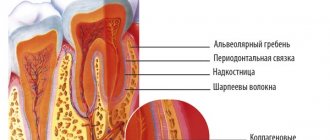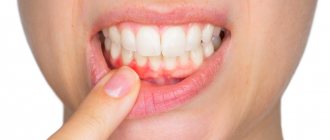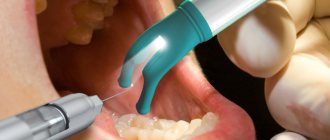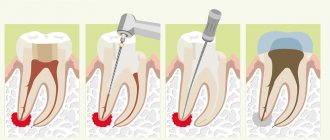05.12.2019
A huge number of people are afraid to visit dentists because dental treatment is usually accompanied by pain and other unpleasant sensations. There is even a special term - dentophobia - fear of dentists, which, according to some data, can describe 84% of patients. However, nowadays, anesthesia comes to the aid of dental phobes, facilitating a calm dental procedure.
But people are usually concerned about how long the freezing effect lasts and how to quickly recover from dental anesthesia, because it can interfere with eating or distort your smile.
Classification of anesthesia in dentistry
Anesthesia, or anesthesia, in dentistry has a certain classification. Various drugs and their types are used in individual cases, depending on the time required by the doctor for the operation, the patient’s condition, and the presence of severe fear or phobia. First of all, anesthesia is divided into two types:
- general anesthesia, or anesthesia;
- local anesthesia.
Anesthesia is usually used only in isolated cases of necessity, if the operation is expected to be very long. So, general anesthesia can last about six hours. Moreover, it has a number of advantages relative to local anesthesia:
- you can remove several teeth or perform several procedures in one go;
- Treatment under general anesthesia is completely painless;
- During anesthesia, the secretion of saliva is blocked, which is very beneficial to the doctor.
However, in most cases there is simply no need for anesthesia, so local anesthesia is used, which is often popularly called tooth freezing.
What to do if the numbness does not go away?
There is no need to be afraid of prolonged tissue numbness; after a couple of hours, sensitivity will definitely return. If numbness in your teeth, tongue, jaw, or nose after anesthesia does not go away by the end of the day, you should call your doctor and report the situation. In rare cases, complications of anesthesia occur in the form of paresis and paresthesia - disruption of tissue innervation. They appear when a nerve is accidentally injured by a needle. In this case, you need to visit a doctor who will prescribe treatment for the pathology. When the anesthesia of the tooth wears off, discomfort and unpleasant sensations may appear.
In most cases, tissue anesthesia passes without a trace, so if there are indications for anesthesia, there is no need to be afraid to perform it. If you have had an unpleasant experience with pain relief or need emergency treatment under anesthesia, you should simply tell your dentist about it. The doctor will definitely take into account your wishes and will be able to control the amount of the drug and the duration of its action.
Features of local anesthesia
Local anesthesia is simple and in most cases can satisfy the need for pain relief, which is why it is especially popular among dentists. In turn, tooth freezing is divided into the following types:
Application anesthesia
It is carried out using gels or sprays that are applied to the gum or cheek. The effect can be observed approximately five minutes after application. However, topical anesthesia is used only in cases where it is necessary to get rid of tartar, remove a falling out or loose tooth, treat gums, or carry out another practically painless procedure, because the spray or gel freezes only the surface of the mucous membrane.
Moreover, topical anesthesia cannot be used for children under five years of age, as well as people with lung diseases.
Infiltration anesthesia, or injection
This type of anesthesia is performed by injecting an anesthetic into the soft tissue located near the diseased tooth to freeze it. It affects the deep layers of tissue. The injection is administered near the location of the entrance of the nerve trunks leading to half of the jaw or its separate part. Usually, not only the cheek and the necessary gums are frozen, but also other organs of the oral cavity, since the exits of all nerves are located close to each other.
It is also important to understand that freezing the upper and lower jaws are somewhat different in their methodology and action due to differences in the structure of the skeleton. Considering that the lower jaw usually has greater loads relative to the upper jaw, evolutionarily it has developed that it has a more dense structure and its muscles are more developed.
Therefore, when injecting an anesthetic into the lower jaw, the needle is inserted deeper, which also affects the duration of the anesthetic.
Contraindications to sedation
We said earlier that not all patients may be suitable for sedation, let's look again at the factors that are contraindicated for sedation.
So these factors are:
- patient's age,
- characteristics of the body, including allergic reactions to drugs that will be administered, that is, incompatibility with sedative drugs in a given patient,
- bad experience that the patient previously had during sedation, and in him it can also cause fear and, accordingly, panic attacks (that “having gone half asleep” the patient may not control himself).
Regarding bad experiences with sedation - yes, such cases are rare, but unfortunately they do occur. Naturally, these characteristics of the body and circumstances will also affect the effect of the drug itself, accordingly, this is a contraindication. For such patients, more careful preparation for sedation is recommended. Or vice versa - we work with such a patient in terms of organizing his treatment under local anesthesia. First, the psychologist communicates with the patient and prepares him. We also work with the patient: we explain that these procedures are for treatment and they are painless, that the quality of anesthetics is now quite high and some patients will not experience pain.
All work during treatment, if we are considering therapeutic treatment, is carried out under a rubber dam,
that is, the patient does not experience any fear that something might get into the oral cavity. And after the first two manipulations in consciousness under local anesthesia, he understands that dentistry has nevertheless made great strides forward, and that it is possible to be treated without sedation without feeling fear.
Duration of action of the anesthetic
A huge number of patients are usually interested in how quickly tooth frost will go away, but it is necessary to understand that the duration of action of the anesthetic depends not only on the type of anesthesia, the area of its application, dosage, the person’s age, metabolic rate and other individual parameters, but also on the painkiller used facilities. Thus, dental anesthetics can be divided into three groups according to the duration of their effect:
- short-acting (Novocaine) – up to twenty minutes;
- medium-acting (Prilocaine, Articaine, Trimecaine, Lidocaine) - from half an hour to an hour;
- long-acting (Bupivacaine) - the effect in some cases can last up to six hours, but usually a sensitivity-blocking dosage is used for two hours.
However, as mentioned above, there are a number of factors that influence the duration of action of the painkiller:
- the presence of inflammation at the site of drug administration;
- the presence of vasoconstrictors in the composition of the anesthetic - substances that narrow blood vessels;
- injection depth;
- site of drug administration;
- chronic diseases of the urinary system;
- individual parameters of the human body.
But in most cases, drugs when injected into the upper jaw last for the next two hours, and when injected into the lower jaw - up to four. However, again, this all depends on the freezing method and many other factors, so if the anesthesia persists for a longer period of time, there is no cause for concern.
Only if freezing remains relevant even after 24 hours should you consult your doctor.
What to do to make dental anesthesia go away faster
Some patients are interested in: what can be done to make dental anesthesia go faster? Unfortunately, we cannot significantly influence the duration of pain relief after treatment or removal. Experts only recommend waiting a certain period of time. You can check with your attending physician how long the freezing will last in your particular case, since he knows exactly what drug he administered and in what quantity.
It is believed that a warm compress will help speed up the frostbite process after a dental appointment. It dilates blood vessels and promotes the removal of anesthetic. But it is contraindicated in the presence of tissue inflammation, diseases of the oral cavity, and can cause complications. Therefore, you cannot apply a compress without a doctor’s recommendation.
Here are some recommendations on what to do to make jaw numbness go away faster:
- Drink a warm drink (tea, juice) that will start your metabolism;
- Have a small meal or snack;
- Get enough rest;
- Avoid physical activity and going to the gym;
- Refrain from bad habits (smoking, drinking alcohol).
Method for reducing the effect of anesthesia
Usually, even after an operation or a procedure requiring anesthesia, the painkiller continues to make itself felt: the lips remain numb, it is not possible to eat normally, the smile becomes distorted. Therefore, people are looking for a way to help the anesthetic stop working as quickly as possible.
In this case, dentists usually recommend applying warm compresses to the cheek. This will help dilate the blood vessels, which will ultimately increase the metabolic rate and remove the anesthetic from the body. However, this is contraindicated after tooth extraction or if inflammation remains. Thus, it is strictly forbidden to heat a tooth or cheek during gumboil. Therefore, it is highly recommended that you consult your dentist initially.
There are two types of anesthesia: local and general.
Local anesthesia includes:
- topical anesthesia, which is used in the form of gels and sprays (used to anesthetize the mucous membrane, for example, during the procedure for removing dental plaque), it lasts for ten to twenty minutes;
- infiltration anesthesia (used for the treatment and removal of teeth most often in the upper jaw and the frontal group of teeth in the lower jaw) lasts for one and a half to two hours;
- conduction anesthesia (for complex surgical procedures and dental treatment in the area of the lower chewing teeth) lasts for two or more hours.
- intraligamentary or intraligamentous anesthesia. This type is done extremely rarely, as a rule, when it is impossible to perform other types of anesthesia.
- intrapulpal anesthesia is used as an additional type of anesthesia during root canal treatment; the feeling of numbness of the tooth occurs quickly and practically stops by the end of treatment.
With all these types, the person is in a state of wakefulness.
General anesthesia includes inhalation and non-inhalation anesthesia. The first option includes anesthesia by mask anesthesia or intubation anesthesia, the second option includes intravenous anesthesia, neuroleptoanalgesia, ataralgesia and a combined method of using local and general anesthesia. In both cases, the person is in a state of sleep, but this type of anesthesia is not used in our dental clinic.
The duration of anesthesia is influenced by many factors, e.g.
- type of anesthesia;
- the correctness of anesthesia and the qualifications of the doctor (since if the injection is performed incorrectly, the anesthetic may have a weak effect, or even may not have any effect at all);
- what anesthetic is used;
- does the anesthetic contain epinephrine (adrenaline) and, if so, in what dilution (the higher the adrenaline content, the longer the effect of anesthesia);
- the amount of anesthetic administered (the larger the dose of anesthetic, the longer the anesthesia lasts);
- on which jaw the anesthesia is performed (since in the area of the upper jaw the bone is more porous and the numbing effect itself occurs quite quickly and sensitivity also returns quickly; in the area of the lower jaw the bone is denser, so here the numbness occurs longer, but this effect also lasts longer).
In our clinic, the main anesthetics used in the dentist's chair are Ultracaine and Ubistezin. Both anesthetics exist in adrenaline dilutions of 1/200,000 and 1/100,000.
Let's now figure out when and in what dilution they need to be used.
At a dilution of 1/100,000, it can be used by all people for infiltration and conduction anesthesia, except for patients:
- with hypersensitivity to anesthetic;
- with diseases of the cardiovascular system (coronary heart disease, tachycardia, arrhythmia, history of myocardial infarction, etc.);
- pregnant, lactating and children;
- with chronic kidney and liver diseases;
- with chronic diseases of the gastrointestinal tract;
- with caution if you have a history of epilepsy.
All of the above are the main absolute and relative contraindications to the administration of an anesthetic with a high content of adrenaline; such patients are administered anesthetics in a dilution of 1/200,000 or without any adrenaline (for example, Mepivacaine).
An important factor in the duration of anesthesia is the person himself:
- If there is an inflammatory process at the site of future manipulation, then the duration of action of the anesthetic is reduced due to the fact that an acidic environment predominates at the site of inflammation, in which the anesthetic is destroyed more quickly;
- If the patient comes excited, overexcited, with fear in his eyes from the upcoming procedure, then the effect of anesthesia will increase, since the content of adrenaline in the body will increase, which constricts blood vessels, which means the anesthetic will be removed from the body more slowly;
- Depending on the age of the patient, the duration of anesthesia also varies. For example, in older people, blood vessels are less permeable, which means that anesthesia will take less time and be less effective;
- Eating fatty foods and alcohol before a dentist visit puts a strain on the liver, which slows down the removal of the anesthetic from the body;
- In chronic liver and kidney diseases, the anesthetic is eliminated from the body more slowly, since they are responsible for removing the anesthetic from the human body.
What needs to be done to ensure that the anesthetic is removed from the body faster and the anesthesia wears off faster:
- While there is a feeling of numbness, you should not eat solid or tough food, so as not to bite your cheeks and lips while chewing, but you can drink. It is recommended to take a warm drink, such as water, tea, warm compress, etc. (not hot, so as not to burn the mucous membrane). Thanks to this, the blood vessels will dilate and the anesthetic will be eliminated from the body faster. However, after tooth extraction, this method cannot be used so as not to cause bleeding from the socket of the extracted tooth;
- The day before the dentist’s appointment, do not drink alcohol or fatty foods in order not to burden the liver, which is responsible for removing the anesthetic from the body;
- To reduce fear and anxiety, you need to take a sedative;
- If the feeling of numbness does not go away within a day or more, then you should immediately consult a dentist.
Anesthesia during pregnancy
Typically, dentists recommend treating teeth and gums while planning pregnancy, because anesthetics can indirectly affect the intrauterine development of the fetus. However, if necessary, it is better to go to the doctor in the second trimester of pregnancy, but if there is an urgent need for treatment, then it can be performed at any stage.
The most modern painkillers, which do not contain adrenaline, are used for pregnant women to avoid the possibility of increased blood pressure and contractions of the uterus. Usually, drugs with minimal toxic effects on the body are also used.
In some cases, pregnant women are transferred to a hospital for treatment.
Thus, all necessary procedures can be carried out under the strict supervision of the attending physician to avoid any complications.
Technology of anesthesia
To ensure complete painlessness, anesthesia is administered into the cavity of the spinal column, located between the membranes of the brain and spinal cord. This area is filled with cerebrospinal fluid - cerebrospinal fluid. Thanks to the anesthetic entering this space, a complete “switching off” of the lower body is achieved. This result is achieved by blocking nerve impulses emanating from the nerve roots of the spine to the brain. Therefore, a person does not feel anything during the action of the drug.
An analgesic agent is injected into the subarachnoid space
Administering spinal anesthesia requires specialist technical skill as the process is not easy. In addition, spinal anesthesia is performed using medical instruments that reduce the risk of complications after anesthesia.
Such tools include:
- alcohol disinfecting cotton swabs for antiseptic procedures;
- two syringes, one of which contains a local anesthetic for a less sensitive spinal puncture. And the second syringe is filled directly with an analgesic agent for spinal anesthesia;
- a special needle for performing a spinal puncture. By the way, it is much thinner than the one used for epidural anesthesia.
Tooth freezing while breastfeeding
Some mothers are afraid to visit dentists while breastfeeding, thinking that anesthetics through milk can have a negative effect on their children. However, there is practically no reason for this.
Neither the anesthetic itself nor the accompanying possible toxic substances are reflected in the milk, because they act only on a certain area of the jaw and are not introduced into the blood.
But in order to further reduce the likelihood of negative effects of drugs on babies, dentists recommend feeding them before visiting the doctor, and also preparing in advance the required amount of milk for the next feeding of the baby. Thus, the toxic substance will not have the opportunity to enter the child’s body.
Category Miscellaneous Published by Mister dentist
The process of spinal anesthesia
After completing all the above doctor’s instructions, you can proceed directly to the anesthetic injection. To do this, the patient must provide the doctor with good access to the spine, taking a position lying on his side, or sitting, with his back bent as much as possible.
This is followed by treatment of the anesthesia injection area with antiseptic drugs and an injection of local anesthetic from the first syringe. Then the anesthesiologist administers the anesthetic, based on the rules for the technique of administering this anesthesia - specifically into the subarachnoid space.
The required dosage of the drug is calculated by the anesthesiologist in advance. It is determined based on an analysis of the individual characteristics of the human body: height, weight, age.
It is worth noting that the puncture site is usually located between the II and III vertebrae of the lumbar spinal column, but it is also acceptable to administer an anesthetic up to the V vertebra. The choice of location for spinal anesthesia depends on the individual structure of the spine, the presence of previous injuries or surgical interventions.
Spinal anesthesia is most often administered between the second and third or third and fourth lumbar vertebrae
Indications for using spinal anesthesia technique
- Surgery of the legs or perineum.
- Reducing the risk of thrombosis in older people during leg surgery.
- Due to the impossibility of administering general anesthesia for lung diseases, both acute and chronic stages.
- Pinched sciatic nerve.
- Radicular syndrome.
- The need to reduce the tone of intestinal muscle tissue during operations on the gastrointestinal tract.
- The need to relax the walls of blood vessels in people with heart problems, with the exception of hypertensive patients and patients with heart valve problems.
There are many indications for the use of spinal anesthesia.
Indications for general anesthesia
In some cases, patients are prescribed only general anesthesia. Such situations include large-scale surgical operations when the doctor is unable to complete them in a short period of time. In cases of dental treatment, general anesthesia is prescribed when the patient needs to have a large number of teeth removed or many implants installed.
Important! Along with this, this anesthesia is prescribed to people with allergies to local anesthetics, patients with a gag reflex during dental therapy, as well as those patients who will undergo surgery on organs above the navel.
Frequently asked questions from patients before agreeing to spinal anesthesia
How will I feel after the anesthesia is administered?
Answer. A couple of minutes after the injection of spinal anesthesia, heaviness in the lower extremities, slight numbness and warmth may be felt. After 15 minutes, the legs will be completely motionless.
How will I feel during the operation?
Answer. During a prolonged operation, a feeling of discomfort may occur due to the long static posture of the body. However, no pain will be felt. Also, discomfort during surgery can be caused by strong touches, stretching of the legs during the doctor's manipulations, or ambient noise. At the request of the patient, the anesthesiologist can put him into a state of light sleep for better comfort. At the same time, the specialist monitors his physical indicators: pulse, blood pressure, breathing and consciousness.
How will I feel after the surgery?











